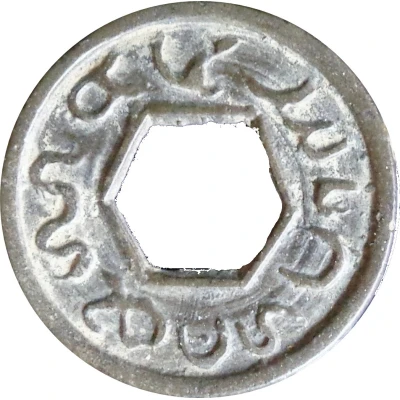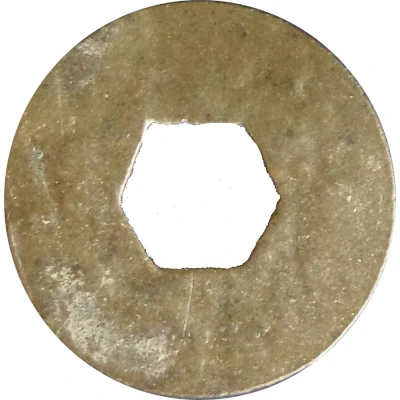1 Pitis - Pangeran Ratu hing Jambi ND
| Tin-lead (possibly with some copper) | 3.61 g | 27 mm |
| Issuer | Sultanate of Jambi (Indonesian States) |
|---|---|
| Type | Circulating commemorative coin |
| Years | 1616-1670 |
| Value | 1 Pitis |
| Currency | Pitis |
| Composition | Tin-lead (possibly with some copper) |
| Weight | 3.61 g |
| Diameter | 27 mm |
| Shape | Round with a square hole |
| Demonetized | Yes |
| Updated | 2024-10-05 |
| Numista | N#344021 |
|---|---|
| Rarity index | 95% |
Reverse
Indistinct rim at edge, similar width to obverse. No lettering.
Comment
This coin was classified in Mitchiner (2012: 31) as a Siak issue based on preliminary reading of the inscription, which he interpreted as sri pangeran siyak 'the lord-king in Siak' in 'Sumatran-Javanese script.' This reading is deferred in the coin's Zeno listing, although with some doubt. Perdana (2022) identify the inscription as late Kawi script which is more plausibly read as pangéran ratu hing jambi.
The title pangéran ratu was initially used in Jambi by reigning monarchs. It was given to the foremost ranking prince only after the title sultan become established in the later half of the 17th century. It is unclear from the coin alone which meaning of pangéran ratu is referred. Based on analogy with Banten copper coinage, this Jambi coin may not have been used as common currency but served as a prestigious form of payment only used by the Jambi court.
See:
- Mitchiner, Michael (2012). “Coin Circulation in Palembang (Sumatra), circa AD 1710 to 1825. Including Coins made in Banten, Siak, Kampar, Indragiri, Jambi, Palembang and Batavia.”
- Perdana, Aditya Bayu (2022). “A Jambi Coin with Kawi Inscription from Indonesia: Re-examination of a coin type formerly attributed to Siak.”
Interesting fact
One interesting fact about this coin is that it is made of a unique material, Tin-lead, which is not commonly used in coin production. The use of this material may have been chosen for its durability, affordability, or aesthetic appeal, and it adds to the coin's distinctiveness and historical significance.

